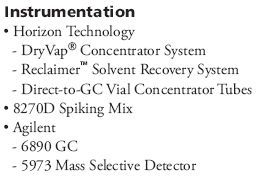Enhancing Recoveries and Maximizing Throughput of Semi-Volatile Organics using the Direct-to-GC-Vial Concentrator Tube and DryVap Concentrator System
The purpose of this study is to determine how the Direct-to-GC vial concentrator tube and the DryVap ® Concentrator System can optimize the recoveries for both low and high boiling point semi-volatile compounds.
The purpose of this study is to determine how the Direct-to-GC vial concentrator tube and the DryVap® Concentrator System can optimize the recoveries for both low and high boiling point semi-volatile compounds. A spiking mixture from EPA method 8270D was chosen due to the more volatile compounds in the mix that are difficult to retain during the concentration and subsequent rinsing process; while the higher boiling compounds are more likely to absorb onto the glass walls.
The DryVap® Concentrator System was intentionally designed to provide enhanced recoveries of semi-volatile organic compounds such as those found in EPA Method 8270D. The unique design of the DryVap® system seals the Direct-to-GC vial concentrator tube inducing condensation of the evaporating solvent on the inside walls of the concentrator tube and forcing the concentrated extract towards the GC vial tip. This condensation, similar to the Kuderna-Danish apparatus, allows condensed solvent to recapture the more volatile compounds so they are not lost to the vapor phase. While this design is beneficial for more volatile compounds, solvent condensation on glass surfaces is a likely source for the adsorption of higher boiling point compounds, especially on the crest and tip of the concentrator tube.

The Direct-to-GC vial concentrating tube eliminates the need to transfer an extract from a concentration tube to a GC vial. This added feature will help you enhance your recoveries by keeping the original glassware from the concentration step to the analysis step. It also reduces the chance of a potential spill or loss of a sample by eliminating the need for traditional pipette transfer techniques to GC vials.

Method Summary
1. Place 125 mL of methylene chloride into a DryVap® Direct-to-GC concentrator tube.
2. Add 50 µg of 8270D Spiking Mix into the 125 mL of methylene chloride.
3. Place the concentration tube on one of the six positions and lower the lid.
4. Configure heater power to 5, nitrogen 20 psi and vacuum to -7 in Hg.
5. Press start and gently push down on the lid to seal the concentration tube.
6. When the sample is done, its position will light up "FINISH", and the DryVap® will beep.
7. Raise the lid and rinse the lower heater coil with 0.25 mL of methylene chloride. The rinse should drip into the bottom of the concentrator tube (this step can be automated by selecting " Auto Rinse Mode 1" on the control panel before starting the concentration process).
8. Using a pipette, rinse the concentrated sample along the bottom flat part of the concentration tube several times.
9. Dispense the concentrated sample back into the GC vial tip of the concentrator tube and read the meniscus to ensure its final volume is at 1.0 mL.
10. Unscrew the GC vial and cap.
11. Run extract on GC–MS.
Results
The recoveries for the 114 semi-volatile compounds were very good, averaging from 86–113%, with the majority in the 90th percentile. Standard deviation and RSD were low showing great reproducibility throughout the concentration process.
Conclusions
The purpose of this study was to demonstrate enhanced semi-volatile recoveries for an extract while truly automating the entire concentration process. Using the Direct-to-GC vial concentrator tube with the DryVap® eliminates the transfer step done in traditional processes allowing for greater efficiency and reproducibility.
Horizon Technology, Inc.,
45 Northwestern Dr., Salem, NH, 03079
tel: (603) 893-3663, fax: (603) 893-4994
Website: www.horizontechinc.com

Follow the Data to Grow: Why a Scientific Data Platform is Essential
October 28th 2024Innovation is the engine that powers a company’s growth and product development, and for enterprises with R&D laboratories, those lab environments are the greatest source of this innovation. In this white paper, learn how a platform approach to scientific data management, including semantic search, advanced analytics, and lab automation, leads to better enterprise decisions at the executive level, optimized lab performance, more discoveries, and stronger product pipelines.
















